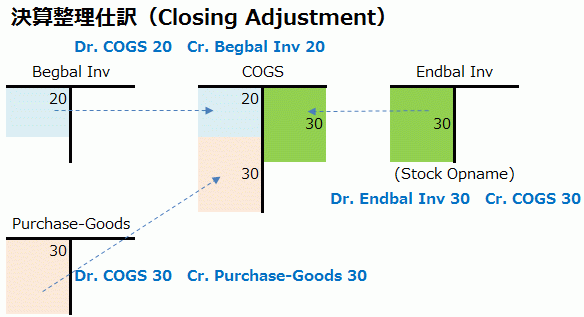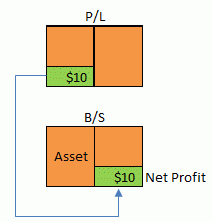Perpetual method
In a system that integrates sales and purchasing inventory management and accounting, sales are recorded on an accrual basis (shipping basis) and products are transferred to COGS (cost of sales) and expensed at the same time, so that the inventory balance in accounting can be grasped continuously.
Since the perpetual method requires the cost of goods (unit price) to be captured at the time of every shipment, in order to synchronize the inventory valuation with the G/L inventory account balance in real time, the inventory receipts and payments valuation is either valued using the moving average unit price or by the FIFO (first-in, first-out) method with full lot control.
In this case, the COGS and Inventories accounts are updated in real time on the G/L of the accounting system.
at the time of receiving
- Dr. Inventories 500,000 Cr. A/P Accrued 500,000
at the time of arrival at Invoice
- Dr. A/P Accrued 500,000 Cr. A/P 500,000
In the case of the shipment standard, where sales are recorded at the time of shipment based on the accrual basis, it is as follows.
at the time of shipment
- Dr. A/R Accrued 600,000 Cr. Sales 600,000
at the time of issuing invoice
- Dr. A/R 600,000 Cr. A/R Accrued 600,000
- Dr. COGS 500,000 Cr. Inventories 500,000
In the case of a customer who issues an invoice after the inspection is completed and is recorded in sales, the inspection standard is as follows.
at the time of shipment
- Dr. Shipment clearing 600,000 Cr. Inventories 600,000
When Invoice is issued
- Dr. COGS 500,000 Cr. Shipment clearing 500,000
- Dr. A/R 600,000 Cr. Sales 600,000
Periodic method
By the periodic inventory system goods arriving during the month are expensed in the Purchasing account, and the difference between Openinig stock, Purchasing and Closing stock is aggregated in the Cost of Goods Sold (COGS) account in the Closing Journal at the end of the month, and the COGS is the difference between the beginning of the month inventory and the inventory at the end of the month.
at the time of receiving
- Dr. Purchase 500,000 Cr. A/P Accrued 500,000
at the time of arrival at Invoice
- Dr. A/P Accrued 500,000 Cr. A/P 500,000
at the time of shipment
- Dr. A/R Accrued 600,000 Cr. Sales 600,000
at the time of issuing invoice
- Dr. A/R 600,000 Cr. A/R Accrued 600,000
In the inventory management system, the quantity can be increased or decreased each time a payment is made or received, and the unit price can be updated using the moving average method only for purchased goods. However, the inventory that arrives is piled up as an expense in the purchase account, and the value of the B/S inventory in the accounting system does not change until the end of the month.
Therefore, the inventory balance on the G/L is not updated during the month, but the valuation is calculated by the physical inventory at the end of the month, and the inventory is synchronized between the inventory management and the accounting by transferring the beginning of the month inventory and the end of the month inventory through the P/L subjects of opening stock and closing stock.
Closing Journal

Transfer inventories to the opening and ending balance
For inventories (materials, work in process, and products), the accounting is synchronized with the inventory by making a transfer journal entry between the amount carried forward at the beginning of the month and the amount of inventory at the end of the month. The opening stock and closing stock accounts are the contra (relative) accounts of the P/L account.
- Dr. Opening stock 20 Cr. Inventories 20
- Dr. Inventories 30 Cr. Closing stock 30
The purchase account is transferred to cost of sales, which is the same expense account.
Transfer to cost of goods sold (COGS) and the COGS balance becomes the cost of goods sold for the month.
- Dr. COGS 20 Cr. Opening stock 20
- Dr. COGS 30 Cr. Purchase Goods 30
- Dr. Closing stock 30 Cr. COGS 30
Re-class all P/L courses
Transfer all P/L accounts, including COGS, to the Net income (income summary) account.
Transfer of net income to retained earnings (Retained earning)
In this case, Net profit is shown as the difference between Expense and Income on the monthly P/L, and Net profit is also shown on the B/S as Net profit in the Assets section.




